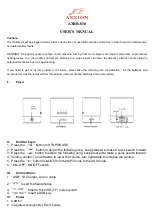
The Subject of Room Acoustics
Acoustics is a complex subject and this text should be treated for what it is, a simple but informative guide.
For a more in depth understanding you would need to refer to a whole range of texts on the subject. The most
important outcome of this should be a greater appreciation of the role played by the room and surroundings
on the overall sound of the audio system. The air contained within the room is the link between the output of
the loudspeaker and your ear. How air behaves is dependant upon the attributes or character of the room.
It follows that a better understanding of basic acoustics and what facets cause the most influence in the
room will assist in making decisions about the way in which the room and subsequently the system can be
improved.
Room types fall between two extremes. A room can be ‘dead’ on the one hand (full of highly energy
absorbent materials and complex diffusing structures) or very ‘lively’ on the other (few reflective surfaces
and a high proportion of very reflective, hard, non absorbent surfaces). As so often is the case a balance of
materials is commonly preferable to one extreme or the other. The correct balance is the goal for the end
user.
Room attributes that can be easily changed
The contents of a room will impact upon its overall acoustic character. As you would expect hard surfaces
like glass and concrete tend to reflect a broad band of acoustic energy. Complimentary materials that are
soft and thick in section such as heavy natural fibre curtains will tend to absorb a broad band of frequencies.
What are standing waves?
When sound waves reflect between two parallel surfaces, the distance apart being equal to half the
wavelength or less, dependant upon wave size, resonance modes referred to as ‘standing waves’ are
created.
In loudspeakers with parallel walls these waves will cause distortions. The standing waves in your room will
distort the frequency response of your system sympathetically boosting certain frequencies. If a certain
standing wave frequency is acoustically isolated from its modal neighbours its effect is more likely to be
audible and problematic. This can compromise the accuracy of any loudspeaker.
Middle & High Frequency Room Characteristics
The middle and high frequencies are affected more by room contents rather than room shape. The surfaces
and how they reflect, absorb or diffuse the acoustic energy will tend to describe the ‘sound’ of a room. Like all
energy, acoustic energy cannot be destroyed; it can only be converted into something else or reflected. The
shape of the surface will determine how it is reflected and the material will determine whether it is absorbed.
All rooms have a particular sound, and to appreciate what influences are present in your particular room you
should be aware of how the objects in your room will respond to sound.
Sound waves behave in the same way as light waves or ‘rays’ and so imagine the driver to be a floodlight.
Reflection: acoustic energy is not converted but reflected in an orderly, predictable fashion.
Diffusion: acoustic energy is dispersed in a random and/or disordered fashion.
Absorption: acoustic energy is converted into kinetic energy or heat. All or a majority of the sound energy is
‘soaked up’ or disposed of by the object surface or room boundary.
2
Содержание Square One Series ii
Страница 1: ...owners manual...






























